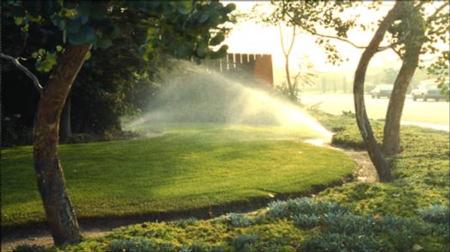Turfgrass Crop Coefficients (Kc)

The Kc’s in Table 1 below adjust ETo to estimate the water required by common turfgrass species to perform as good quality lawns or other general turf surfaces. Intensively used and high-performance sports turf surfaces may require more water than these Kc’s provide in order to meet recovery and performance expectations.
The annual average Kc’s are most commonly used, but monthly values more precisely match turfgrass needs through the year.
| Month |
Cool-Season2 |
Warm-Season3 |
| January |
0.61 |
0.61 |
| February |
0.64 |
0.54 |
| March |
0.75 |
0.76 |
| April |
1.04 |
0.72 |
| May |
0.95 |
0.79 |
| June |
0.88 |
0.68 |
| July |
0.94 |
0.71 |
| August |
0.86 |
0.71 |
| September |
0.74 |
0.62 |
| October |
0.75 |
0.54 |
| November |
0.69 |
0.58 |
| December |
0.60 |
0.55 |
| Annual Average |
0.80 |
0.60 |
1 Meyer et al. 1985. Irrigation of turfgrass below replacement of evapotranspiration as a means of water conservation: determining crop coefficient of turfgrasses, pp. 357-364 in: F. Lemaire (ed.) Proc. 5th Intl. Turfgrass Research Conf., Avignon, France, July 1985. INRA Publications, Versailles, France.
2 Species include tall fescue, ryegrass, bentgrass, and Kentucky bluegrass.
3 Species include bermudagrass, zoysiagrass, and St. Augustinegrass.
Note even though tall fescue is the reference crop for estimating ETo, turfgrasses require an amount of water that is less than ETo to provide acceptable performance during most of the year. However, the total amount of water needed to be applied to turfgrass through irrigation usually equals or exceeds ETo because of inefficiency and non-uniformity of the irrigation system. Also, note that warm-season turfgrasses (bermudagrass, zoysiagrass, St. Augustinegrass) require about 20% less water than cool-season turfgrasses (tall fescue, rye grass, Kentucky bluegrass) during the growing season.
The turfgrass Kc’s are used with ETo data to determine the approximate amount of water that a lawn or other turfgrass planting will need for good performance. For example, to perform acceptably in a lawn, bermudagrass needs about 60% of ETo on an annual average. If ETo for a day is 0.20 inches a day, then bermudagrass would use 0.12 inches (0.20 in. × 0.6) per day.
Tall fescue and other cool-season grasses will survive and provide soil cover with many brown areas, considerable thinning out, and little growth if they receive about 60% of ETo. Bermuda and other warm-season grasses will provide similar minimal performance when irrigated at about 40% of ETo.
